
A camel is an even-toed ungulate in the genus Camelus that bears distinctive fatty deposits known as "humps" on its back. Camels have long been domesticated and, as livestock, they provide food and textiles. Camels are working animals especially suited to their desert habitat and are a vital means of transport for passengers and cargo. There are three surviving species of camel. The one-humped dromedary makes up 94% of the world's camel population, and the two-humped Bactrian camel makes up 6%. The wild Bactrian camel is a distinct species that is not ancestral to the domestic Bactrian camel, and is now critically endangered, with less than 1,000 individuals.
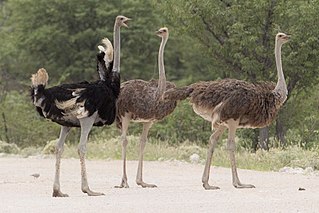
The common ostrich, or simply ostrich, is a species of flightless bird native to certain large areas of Africa. It is one of two extant species of ostriches, the only living members of the genus Struthio in the ratite order of birds. The other is the Somali ostrich, which was recognized as a distinct species by BirdLife International in 2014 having been previously considered a distinctive subspecies of ostrich.

Camelids are members of the biological family Camelidae, the only currently living family in the suborder Tylopoda. The seven extant members of this group are: dromedary camels, Bactrian camels, wild Bactrian camels, llamas, alpacas, vicuñas, and guanacos. Camelids are even-toed ungulates classified in the order Artiodactyla, along with species including whales, pigs, deer, cattle, and antelopes.

The dromedary, also known as the dromedary camel, Arabian camel, or one-humped camel, is a large camel, of the genus Camelus, with one hump on its back.
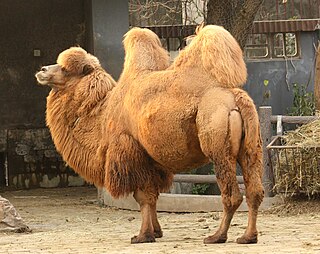
The Bactrian camel, also known as the Mongolian camel, domestic Bactrian camel or two-humped camel, is a large camel native to the steppes of Central Asia. It has two humps on its back, in contrast to the single-humped dromedary. Its population of 2 million exists mainly in the domesticated form. Their name comes from the ancient historical region of Bactria.

Lama is a genus containing the extant South American camelids: the wild guanaco and vicuña and the domesticated llama, alpaca, and chilihueque. Before the Spanish conquest of the Americas, llamas, alpacas, and chilihueques were the only domesticated ungulates of the continent. They were kept not only for their value as beasts of burden, but also for their flesh, hides, and wool.
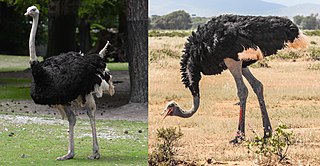
Ostriches are large flightless birds. Two living species are recognised, the common ostrich, native to large areas of sub-Saharan Africa, and the Somali ostrich, native to the Horn of Africa.

The Arabian ostrich, Syrian ostrich, or Middle Eastern ostrich is an extinct subspecies of the ostrich that lived on the Arabian Peninsula and in the Near East until the mid-20th century.

The Somali ostrich, also known as the blue-necked ostrich, is a large flightless bird native to the Horn of Africa. It is one of two living species of ostriches, the other being the common ostrich. It was also previously considered a subspecies of the common ostrich, but was identified as a distinct species in 2014.
Margaric acid, or heptadecanoic acid, is a saturated fatty acid. Its molecular formula is CH3(CH2)15CO2H. Classified as an odd-chain fatty acid, it occurs as a trace component of the fat and milkfat of ruminants. Salts and esters of margaric acid are called heptadecanoates.

Camelini is a tribe of camelids including all camelids more closely related to modern camels (Camelus) than to Lamini, from which camelines split Approximately 17 million years ago. The tribe originated in North America, with the genus Paracamelus migrating over the Bering Land Bridge into Eurasia during the Late Miocene, around 6 million years ago, becoming ancestral to Camelus. The last member of Camelini in North America was Camelops, which became extinct as part of the Quaternary extinction event at the end of the Late Pleistocene, around 12,000 years ago.
Paracamelus is an extinct genus of camel in the family Camelidae. It originated in North America During the Hemphillian, around 7 million years ago, and crossed the Beringian land bridge into Eurasia during the Late Miocene, around 6 million years ago (Ma). It is the presumed ancestor to living camels of the genus Camelus.
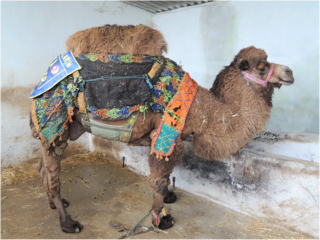
The hybrid camel is a domestic camelid hybrid between a Bactrian camel and dromedary. It is the offspring of a male Bactrian camel and a female dromedary.
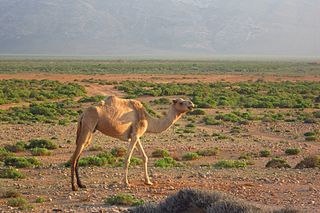
Camel urine is a liquid by-product of metabolism in a camel's anatomy. Urine from camels has been used in prophetic medicine for centuries, being a part of ancient Bedouin practices and also Muslim tradition. According to the World Health Organization, the use of camel urine as a medicine lacks scientific evidence. After the spread of MERS-CoV infections, the WHO urged people to refrain from drinking "raw camel milk or camel urine or eating meat that has not been properly cooked".

The wild Bactrian camel is a critically endangered species of camel living in parts of northwestern China and southwestern Mongolia. It is closely related but not ancestral to the domestic Bactrian camel. Genetic studies have established it as a separate species which diverged from the Bactrian camel about 0.7-1.1 million years ago.

Bou-Hedma National Park is located in both the Gafsa Governorate and Sidi Bouzid Governorate, in Tunisia. The park was created on December 18, 1980, and has been on the UNESCO tentative list of World Heritage Sites since May 28, 2008
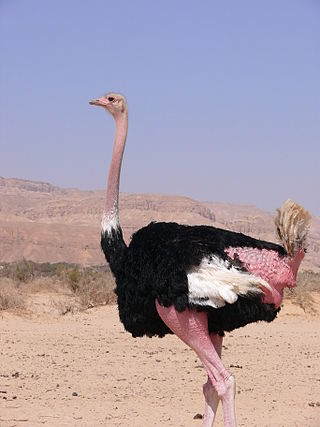
The North African ostrich, red-necked ostrich, or Barbary ostrich is the nominate subspecies of the common ostrich from West and North Africa. It has the largest average size among the subspecies of ostriches, making it the largest living bird.

The South African ostrich, also known as the black-necked ostrich, Cape ostrich or southern ostrich is a subspecies of the common ostrich endemic to Southern Africa. It is widely farmed for its meat, eggs and feathers.

The Masai ostrich, also known as the East African ostrich is a red-necked subspecies variety of the common ostrich and is endemic to East Africa. It is one of the largest birds in the world, second only to its sister subspecies Struthio camelus camelus. Today it is hunted and farmed for eggs, meat, and feathers.
Daxata laosensis is a species of beetle in the family Cerambycidae. It was described by Stephan von Breuning in 1938. It is known from Laos.
















